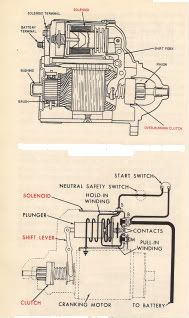Please give me the bypass info. Thanks.
After reading all the post on this problem I must admit you sher have gone though a lot of work for a bad battery connection. You need to stop now, and stop second guessing your problems , do not complicate the problem by putting in the wiring by pass. You your self said, I quote ( You're talking to a very "un-electrical" guy,) you do nothing more than put your self in a deeper hole.
so what to do? work on one problem at a time, and one circuit at a time.
First get tools you will need, 12 volt test light, volt /ohm meeter that has a continuity buzzer on it, and a wiring diagram for your system.
put your wiring back together, make sure you have a good ground connection to the engine block from the frame and frame to the battery ground.
the positive side of the battery goes to the starter then up to the fuse block though a 30 amp fuse to the amp meeter to the key and back to the fuse block buss bar, a buss bar is where all individual fuses come off of to start there own circuit protection like the glow plugs. Now the fun begins ,, take the test light hook to the engine (ground) and touch the positive side of the battery (+), light should work, this tests that your ground is good. now put the light to the fuse block with all the fuses removed and fine the power side of the block it will be the 30 ammeter fuse. , and no other fuse slot will have power. install the 30 amp fuse and turn the key to on , now the rest of the fuse buss bar will come to life.
now I would put the 10 amp regulator fuss in, hook up the volt meeter to the battery it should read 12 volts, and start the engine the meeter should read 13-14 volts. if not take it off and to a auto store and have it tested. remember all wiring coming off the fuse block comes from the + side of the battery and when fuse blows it's because gone to ground be it from chafing, part burning out and going to ground or the wire was hook up by mistake to ground.
now its a matter of going though each fused circuit and seeing if it works if not you will have to find the short and fix it..
I hope this helps
keep it simple stupid! for the more complicated you make it the stupider you become
